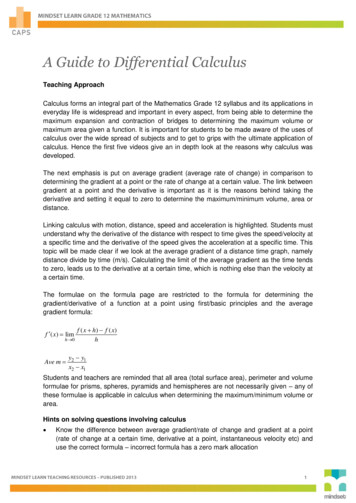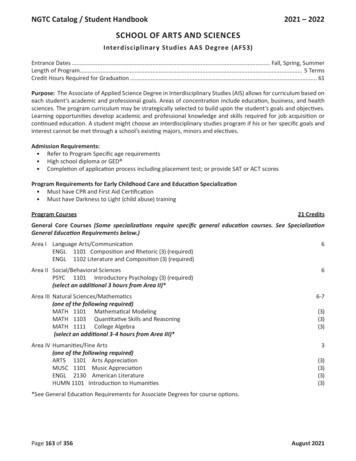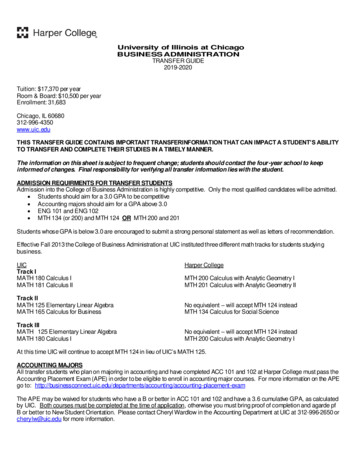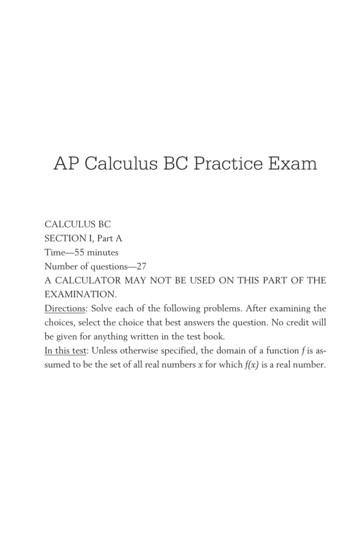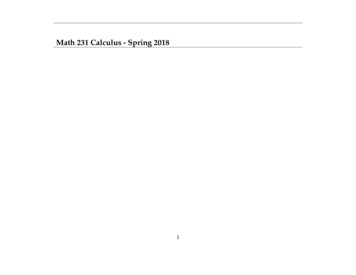
Transcription
Math 231 Calculus - Spring 20181
§2.2 THE LIMIT OF A FUNCTION§2.2 The Limit of a FunctionExample. Julia’s sushi and salad buffet costs 10 per pound, but if you getexactly one pound, your meal is free. Let y f (x) represent the price ofyour lunch in dollars as a function of its weight x in pounds.Write an equation y f (x) as a piecewise defined function.Draw a graph of y f (x).Describe the behavior of f (x) when x is near 1 but not equal to 1.2
§2.2 THE LIMIT OF A FUNCTIONDefinition. (Informal definition) For real numbers a and L, lim f (x) Lx ameans3
§2.2 THE LIMIT OF A FUNCTIONExample. Describe the behavior of g(x) (graphed below) when x is near 2.Definition. (Informal definition) For real numbers a and L,lim f (x) L meansx a lim f (x) L meansx a 4
§2.2 THE LIMIT OF A FUNCTIONExample. Describe the behavior of y h(x) when x is near 2 in terms oflimits.END OF VIDEO5
§2.2 THE LIMIT OF A FUNCTIONReview. lim f (x) 5 means:x 2lim f (x) 4 means:x 3 lim f (x) 1 means:x 3 lim f (x) means:x 1 6
§2.2 THE LIMIT OF A FUNCTIONExample. For the function f (x) graphed below,Findlim f (x)lim f (x)x 1 lim f (x)x 1lim f (x)lim f (x)lim f (x)lim f (x)x 1 x 1 lim f (x)x 2 x 2 lim f (x)x 1 x 1x 2At what values of a does lim f (x) fail to exist as a finite number?x a7
§2.2 THE LIMIT OF A FUNCTIONTrue or False. If lim f (x) 5 then f (2) 5.x 2True or False. If f (2) 5 then lim f (x) 5.x 2True or False. If lim f (x) and lim f (x) exist, then lim f (x) exists.x ax ax a8
§2.2 THE LIMIT OF A FUNCTIONNote. Ways that limits can fail to exist as a finite number:9
§2.2 THE LIMIT OF A FUNCTION π? Use a table of values for evidence.Example. What is lim sinx 0x10
§2.2 THE LIMIT OF A FUNCTIONExtra Example. Sketch the graph of a function f (x) defined for 2 x 3with the following properties:1. lim f (x) 3x 22. lim f (x) 2x 03. f (0) 44. lim f (x) x 15. lim f (x) 4x 16. f (1) 47. lim f (x) 0x 311
§2.2 THE LIMIT OF A FUNCTIONExtra Example. Use a table of values to estimate the value of the limit.Use a graph to confirm your result.sin(x)1. limx 0 sin(πx) x 3 2. limx 3 x 3x 13. limx 1 x 112
§2.3 CALCULATING LIMITS§2.3 Calculating LimitsAfter completing this section, students should be able to: Compute limits by plugging in x-values when possible. Use the limit laws to compute a limit when the limits of componentsare known.0 Recognize indeterminate forms.00 Use algebra to rewrite indeterminate limits in forms that allow them0to be computed by plugging in x-values, when possible, including thetechniques of factoring, distributing, simplifying complex fractions,rationalizing the numerator, and evaluating absolute values usingcases.0 Give examples of limits in indeterminate forms that evaluate to0various finite numbers, evaluate to infinity or negative infinity, or donot exist.13
§2.3 CALCULATING LIMITSf (x)?x 7 3g(x)Example. Suppose lim f (x) 30 and lim g(x) 2. What is limx 7x 7Theorem. (Limit Laws) Suppose that c is a constant and the limits lim f (x) andx alim g(x) exist as finite numbers. Thenx a lim[ f (x) g(x)]x a lim[ f (x) g(x)]x a lim[c f (x)]x a lim[ f (x)g(x)]x a limx af (x)g(x), provided that14
§2.3 CALCULATING LIMITSx2 3x 6Example. Find limx 2x 915
§2.3 CALCULATING LIMITSThe Squeeze TheoremExample. For the function g(x) suppose that, for x-values near 1, 4 x g(x) 3x2 4x 5What can we say about lim g(x)?x 116
§2.3 CALCULATING LIMITSTheorem. (The Squeeze Theorem)17
§2.3 CALCULATING LIMITS 1.Example. Find lim x2 sinx 0xEND OF VIDEO18
§2.3 CALCULATING LIMITS( f (x))2Question. If lim f (x) 4 and lim g(x) 8, then what is lim?x 7x 7x 7 g(x) 10Note. The limit laws make it easy to evaluate limits likex 7x 2 x2 1limWhat is the easy way to evaluate this and what is the answer?19
§2.3 CALCULATING LIMITSQuestion. Which of these limits can be evaluated just by plugging in? x 3A. lim 2x 3 x 1 4xB. limx 3 x 3x2 2x 15C. lim 2x 3 x x 6Note. limx af (x)can usually be evaluated just by plugging in a as long as .g(x)20
§2.3 CALCULATING LIMITSQuestion. When lim g(x) 0, how can we find limx ax a21f (x)?g(x)
§2.3 CALCULATING LIMITSExample. Use algebra to find the following limits. If the limit DNE as afinite number, decide if it is , , or just DNE.1.2.3.4.5.x2 2x 15lim 2x 3 x x 6(5 z)2 25limz 0z11r 3 3limr 0r x 3 2limx 1x 12x 10limx 5 x 5 22
§2.3 CALCULATING LIMITSx2 2x 151. lim 2x 3 x x 623
§2.3 CALCULATING LIMITS(5 z)2 252. limz 0z24
§2.3 CALCULATING LIMITS3. limr 01r 3 13r25
§2.3 CALCULATING LIMITS 4. limx 1x 3 2x 126
§2.3 CALCULATING LIMITS2x 10x 5 x 5 5. lim27
§2.3 CALCULATING LIMITS1.2.3.4.5.x2 2x 15lim 2x 3 x x 6(5 z)2 25limz 0z11 lim r 3 3r 0r x 3 2limx 1x 12x 10limx 5 x 5 Question. Do all 00 limits exist?28
§2.3 CALCULATING LIMITSNote. If lim f (x) 0 and lim g(x) 0 then limx ax ax a29f (x)COULD BE .g(x)
§2.3 CALCULATING LIMITSQuestion. True or False: If f (x) g(x) h(x) near x 3 and lim f (x) existsx 3and lim h(x) exists, then lim g(x) exists.x 3x 3Question. True or False: If f (x) g(x) h(x) near x 3 and lim f (x) andx 3lim h(x) both exist and are equal to each other, then lim g(x) exists.x 3x 330
§2.3 CALCULATING LIMITSExample. Supposef (t) t2 3t 1t2 t 6 t 32tt 2Find lim f (t), if possible.t 131
§2.4 INFINITE LIMITS§2.4 Infinite Limitsx 1and horizonx(2/3) 1tal and vertical asymptotes that needs to be replaced.NOTE: THERE IS A SUPER HARD HWK ABOUTAfter completing this section, students should be able to: Explain the relationship between infinite limits and vertical asymptotes. Use logical reasoning about positive and negative numbers and largef (x)when the limitand small numbers to compute the limit of a ratiog(x)of the numerator is not zero and the limit of the denominator is zero.32
§2.4 INFINITE LIMITSNote. The Limit Law about quotients tells us thatf (x) limx a f (x) limx a g(x)limx a g(x)provided that .Question. What if lim g(x) 0?x a33
§2.4 INFINITE LIMITS 4xx 3 x 3Example. Find lim34
§2.4 INFINITE LIMITS5xx 4 x 4 Example. Find limEND OF VIDEO35
§2.4 INFINITE LIMITSIn the next two sections, we will be considering two types of limits:limits OF infinityandlimits AT infinity.A limit OF infinity (or an infinite limit) means.A limit AT infinity means .Example. In the figure, what isA. lim f (x)?x 1B. lim f (x)?x 1C. lim f (x)?x D. lim f (x)?x 36
§2.4 INFINITE LIMITSQuestion. If lim f (x) , then .x aA. the graph of y f (x) has a horizontal asymptote at y aB. the graph of y f (x) has a vertical asymptote at x aC. Neither of these are necessarily true.Question. If lim f (x) a, then .x A. the graph of y f (x) has a horizontal asymptote at y aB. the graph of y f (x) has a vertical asymptote at x aC. Neither of these are necessarily true.Question. What is the relationship between asymptotes and limits?37
§2.4 INFINITE LIMITSx 2x 6 x 6Example. Find lim38
§2.4 INFINITE LIMITS2x x2Example. Find limx 5 (x 5)239
§2.4 INFINITE LIMITSQuestion. If lim f (x) 3 and lim g(x) 0, what COULD limx ax ax af (x)equal?g(x)f (x)What COULD limequal?x a (g(x))2Question. If lim f (x) 0 and lim g(x) 0, what COULD limx ax ax a40f (x)equal?g(x)
S2.5 LIMITS AT INFINITYS2.5 Limits at InfinityAfter completing this section, students should be able to: Explain the relationship between limits at infinity and horizontalasymptotes. Compute limits at infinity for ratios of polynomials by factoring outthe highest powers of x in the numerator and in the denominator. Compute the limits at infinity for ratios of polynomials by comparingthe degrees of the polynomials. Compute the limits at infinity for ratios of expressions involving thesquare roots of polynomials.41
S2.5 LIMITS AT INFINITYExample. What happens to f (x) as x goes through larger and larger positive numbers? Larger and larger negative numbers?42
S2.5 LIMITS AT INFINITYExample. For the functions g(x) and h(x) drawn below, what are the limitsat infinity?43
S2.5 LIMITS AT INFINITYExample. What are1x xExample. What are1x x3limlimandand1 0 whenever .x xrNote. limEND OF VIDEO441?x xlim1lim ?x x
S2.5 LIMITS AT INFINITYQuestion. If lim f (x) a, then .x A. the graph of y f (x) has a horizontal asymptote at y aB. the graph of y f (x) has a vertical asymptote at x aC. Neither of these are necessarily true.Question. If lim f (x) , then .x aA. the graph of y f (x) has a horizontal asymptote at y aB. the graph of y f (x) has a vertical asymptote at x aC. Neither of these are necessarily true.Question. What is the relationship between asymptotes and limits?45
S2.5 LIMITS AT INFINITY5x2 4xExample. Evaluate lim 3x 2x 11x2 12x46
S2.5 LIMITS AT INFINITY3x3 6x2 10x 2Example. Find limx 2x3 x2 547
S2.5 LIMITS AT INFINITYx4 3x2 6Example. Find limx 5x2 x 248
S2.5 LIMITS AT INFINITYRecap:5x2 4xlimx 2x3 11x2 12x3x3 6x2 10x 2limx 2x3 x2 5x4 3x2 6limx 5x2 x 249
S2.5 LIMITS AT INFINITYQuestion. What can we say about limits for rational expressions? (Arational expression is a .1. If the degree of f (x) is less than the degree of g(x), then limx f (x)g(x) .2. f the degree of f (x) is greater than the degree of g(x), then limx 3. If the degree of f (x) is equal to the degree of g(x), then limx 50f (x)g(x)f (x)g(x).
S2.5 LIMITS AT INFINITYExample. Find lim 2x3 11x2 12xx sin2(x)Example. Find limx x351
S2.5 LIMITS AT INFINITYQuestion. What are the horizontal and vertical asymptotes of f (x) 1 4x2?2x2 xQuestion. True or False: A function can have at most one horizontalasymptote.52
S2.5 LIMITS AT INFINITYExample. Find 13x2 3x 2limx 5x 6 13x2 3x 2limx 5x 6and53
§2.6 CONTINUITY§2.6 ContinuityAfter completing this section, students should be able to: State the limit definition of continuity. Use a graph to determine where a function is discontinuous and why. Define continuous from the left and from the right. Find intervals on which a function is continuous based on a graph oran equation. For a piecewise defined function, determine if the function is continuous on ”transition” x-values, that is, the x-values that are the endpointsof intervals where it defined by different formulas. For a piecewise defined function defined in terms of a parameter,determine values of the parameter that will make the function continuous, if possible. Based on a graph or an equation, determine if a function has a removable discontinuity at a given x-value, and if so, what value thefunction could be given at that point to make it continuous.54
§2.6 CONTINUITY State the Intermediate Value Theorem. Use the Intermediate Value Theorem to prove that an equation has asolution in a given interval.55
§2.6 CONTINUITYDefinition. (Informal Definition) A function f (x) is continuous ifQuestion. What are some ways that a function can fail to be continuous?56
§2.6 CONTINUITYDefinition. A function f (x) is continuous at a number a if1.2.3.57
§2.6 CONTINUITYExample. What are all the places where f is not continuous, and why?58
§2.6 CONTINUITYExample. Consider the function f (x) at x 2 and at x 1.Definition. A function f (x) is continuous from the left at x a ifA function f (x) is continuous from the right at x a ifEND OF VIDEO59
§2.6 CONTINUITYReview. We say that a function f (x) is continuous at x a if .At what points is f discontinuous, and why?60
§2.6 CONTINUITY1. At what points is f continuous from the right but not continuous?2. At what points is f continuous from the left but not continuous?Question. If f (x) is continuous from the left and from the right at x a, isit continuous at x a?61
§2.6 CONTINUITYExample. Consider the function defined as follows, where a and b areunknown constants. ax2if x 2 f (x) bx x 3 if 2 x 1 4 axif 1 xWhat values of a and b will make f continuous?62
§2.6 CONTINUITYDefinition. We say that a function f (x) is continuous on the interval (b, c)ifWe say that f (x) is continuous on an interval [b, c] if63
§2.6 CONTINUITYExample. On what intervals is g(x) continuous?64
§2.6 CONTINUITYQuestion. What kinds of functions are continuous everywhere?Question. What kinds of functions are continuous on their domains?65
§2.6 CONTINUITYQuestion. What kinds of functions are NOT continuous on all of theirdomains?66
§2.6 CONTINUITYExample. For what real numbers is f (x) ln67 cos2 (x)x discontinuous?
§2.6 CONTINUITYExample. Find lim cos(x).x 0!(x2 4)πExample. Find lim cos.x 212x 24Note. If f (x) is continuous, them lim f (g(x)) x a68
§2.6 CONTINUITYQuestion. True or False: If f (x) is continuous on [0, 4] and f (0) 5 andf (4) 1, then f (a) 2 for some number a.Theorem. (Intermediate Value Theorem)69
§2.6 CONTINUITYExample. Prove that the polynomialp(x) 5x4 3x3 12x 25has a real root.70
§2.6 CONTINUITYQuestion. Are there two points on exactly opposite sides of the earth thatat this moment have the exact same temperature?71
S3.1 INTRODUCTION TO DERIVATIVESS3.1 Introduction to DerivativesAfter completing this section, students should be able to: State the limit definition of derivative in two different forms. Use the limit definition of derivative to compute the slope and theequation of a tangent line. Explain the relationship between secant lines and tangent lines. Explain the relationship between average rate of change and instantaneous rate of change. Explain how derivatives are related to tangent lines. Given a limit expression, identify it as the definition of a derivative ofa function at a point, and identify which function and which point.72
S3.1 INTRODUCTION TO DERIVATIVESSecant Lines and Tangent LinesFind the slope of the tangent line.73
S3.1 INTRODUCTION TO DERIVATIVESIn general, to find the slope of the tangent line for a function y f (x) atthe point (a, f (a)), we can take a limit of slopes of secant lines.The slope of a secant line through (a, f (a)) and (x, f (x)) is:The slope of the tangent line at (a, f (a)) is:74
S3.1 INTRODUCTION TO DERIVATIVESAn alternate expression for the slope of the tangent line at (a, f (a)) is:Definition. The derivative a function y f (x) at an x-value a is:OR75
S3.1 INTRODUCTION TO DERIVATIVESExample. The following expressions represent the derivative of somefunction at some value a. For each example, find the function and thevalue of a.(x 5)2 161. limx 1x 132 h 92. limh 0hEND OF VIDEO76
S3.1 INTRODUCTION TO DERIVATIVESReview. The derivative of a function f (x) at x a, is defined as the, which is the limit of theslope of the.slopes ofThe slope of a secant line through (a, f (a)) and (x, f (x)) is:An alternate expression for the slope of this secant line is:77
S3.1 INTRODUCTION TO DERIVATIVESThe slope of the tangent line at (a, f (a)) is:OR78
S3.1 INTRODUCTION TO DERIVATIVES1Example. (a) Write out the limit definition of the derivative of f (x) 3 xat a 1.(b) Calculate the derivative of f (x) 7913 xat a 1.
S3.1 INTRODUCTION TO DERIVATIVES(c) Find the equation of the tangent line to f (x) with x-value -1.8013 xat the point
S3.1 INTRODUCTION TO DERIVATIVESExample. (a) Find the derivative of y x2 3x at a 2.81
S3.1 INTRODUCTION TO DERIVATIVES(b) Find the derivative of y x2 3x at an arbitrary value x a.82
S3.1 INTRODUCTION TO DERIVATIVES(c) Find the equation of the tangent line to y x2 3x at a point withx-value of 5.83
S3.1 INTRODUCTION TO DERIVATIVESExample. This expression represents the derivative of what functionat which value of a? 12x 6limx 3x 3Example. This expression represents the derivative of what functionat which value of a?tan( 3π4 h) 1limh 0h84
S3.1 INTRODUCTION TO DERIVATIVESDerivatives and Rates of ChangeExample. The graph of y f (x) represents my distance from campus ona bike ride heading due north. Interpret the slope of secant line through the points (3, f (3)) and(4, f (4)). Interpret the slope of the tangent line at x 3 .85
S3.1 INTRODUCTION TO DERIVATIVESExtra Example. Suppose f (x) represents the temperature of your coffee indegrees Fahrenheit as a function of time in minutes x since you’ve set iton the counter. Interpret the following equations and give the units.1. f (0) 1402. f (10) f (0) 203.f (10) f (0) 2104. f 0(15) 0.586
S3.1 INTRODUCTION TO DERIVATIVESSummary: Organize the following list of expressions by putting terms related to average rate of change on the left terms related to instantaneous rate of change on the rightf (x) f (a)slope of tangent lineslope of secant linex af (x) f (a)average velocityinstantaneous velocitylimx ax aderivativeAverage Rate of ChangeInstantaneous Rate of Change87
§3.2 WORKING WITH DERIVATIVES§3.2 Working with DerivativesAfter completing this section, students should be able to: Use a graph of a function to determine when the derivative will bepositive, negative, 0, and undefined. Sketch the graph of the derivative of a function based on the graph ofthe function. Explain the relationship between a function being continuous at apoint and the function being differentiable at the point.88
§3.2 WORKING WITH DERIVATIVESExample. The height of an alien spaceship above the earth’s surface isgraphed below. Graph the rate of change of the height as a function oftime.89
§3.2 WORKING WITH DERIVATIVESExtra Example. The graph of y f (x) is shown below. Sketch f 0(x).90
§3.2 WORKING WITH DERIVATIVESNote. Ways that a derivative can fail to exist at x a.91
§3.2 WORKING WITH DERIVATIVESDefinition. A function is differentiable at x a if .Definition. A function is differentiable on an open interval (b, c) if .Theorem. If f (x) is not continuous at x a, then .If f (x) is differentiable at x a, then .If f (x) is continuous at x a,92
§3.3 RULES OF DIFFERENTIATION§3.3 Rules of DifferentiationAfter completing this section, students should be able to: Explain why the derivative of a constant function is 0. Compute the derivative of a sum or difference of functions from thederivative of each function. Compute the derivative of a constant multiple of a function from thederivative of the function. Use the power rule to compute the derivative of powers of x such asf (x) x7. Compute the derivative of f (x) ex. Explain what a second derivative is and recognize different notationsfor second derivatives and higher order derivatives.93
§3.3 RULES OF DIFFERENTIATION1. Derivative of a constant2. Derivative of f (x) x94
§3.3 RULES OF DIFFERENTIATION3. Power RuleExample. Find the derivatives of these functions:1. y x152. f (x) 3x3. g(x) 1x3.795
§3.3 RULES OF DIFFERENTIATION4. Derivative of a constant multipleExample. Find the derivative of f (x) 5x3.96
§3.3 RULES OF DIFFERENTIATION5. Derivative of a sum6. Derivative of a differenceExample. Find the derivative of y 7x3 5x2 4x 2.END OF VIDEO97
§3.3 RULES OF DIFFERENTIATIONQuestion. Which of the following is NOT a correct derivative rule? (crepresents a constant) 0A.ddx cB.ddx c f (x)C.ddx f (x) g(x) D.ddx f (x) · g(x) E.d cdx xd c dxf (x)ddxddxdf (x) dxg(x)df (x) · dxg(x) cxc 198
§3.3 RULES OF DIFFERENTIATIONExample. Calculate the derivative: y x πExample. Calculate the derivative: g(t) 4t2 9914t2
§3.3 RULES OF DIFFERENTIATIONExample. Find the slope of the tangent line to y 1003x2 2xxat x 41 .
§3.3 RULES OF DIFFERENTIATIONExample. At what x-values is the tangent line of this graph horizontal?y x3(x2 10x 15)101
§3.3 RULES OF DIFFERENTIATIONHigher Order Derivatives:Definition. The second derivative of f (x) is .102
§3.3 RULES OF DIFFERENTIATIONExtra Example. Find f (100)(1) if f (x) (x2 7x 9)5.103
§3.3 RULES OF DIFFERENTIATIONThe Marvelous Number ey ex104
§3.3 RULES OF DIFFERENTIATIONThree facts about e.1.2.3.105
§3.3 RULES OF DIFFERENTIATIONAnother fact about e.4.106
§3.3 RULES OF DIFFERENTIATION2Example. Find the derivative of g(x) ex2 2ex xe2 xe .Extra Example. Find the derivative of y e3.107
§3.3 RULES OF DIFFERENTIATIONNote. For a constant c,d(c) 0.dxProof. .Note.d(x) 1.dxProof. .108
§3.3 RULES OF DIFFERENTIATIONTheorem. (The Power Rule)d n(x ) nxn 1dxProof. (Proof for n a positive integer only).109
§3.3 RULES OF DIFFERENTIATIONTheorem. (Constant Multiple Rule) If c is a constant, and f is a differentiablefunction, thendd[c f (x)] c f (x)dxdxProof. .110
§3.3 RULES OF DIFFERENTIATIONTheorem. (Sum Rule) If f and g are differentiable functions, thenddd[ f (x) g(x)] f (x) g(x)dxdxdxProof. .111
§3.3 RULES OF DIFFERENTIATIONTheorem. (Difference Rule) If f and g are differentiable functions, thenddd[ f (x) g(x)] f (x) g(x)dxdxdxProof. .112
§3.4 THE PRODUCT RULE AND THE QUOTIENT RULE§3.4 The Product Rule and the Quotient RuleAfter completing this section, students should be able to: Use the product rule to compute the derivative of the product offunctions from the derivatives of the functions. Use the quotient rule to compute the derivative of the quotient offunctions from the derivatives of the functions. Use the product rule, quotient rule, and other rules repeatedly withinthe calculation of a derivative of a function. Compute the derivative of a function of the form f (x) ek x, where kis a number.113
§3.4 THE PRODUCT RULE AND THE QUOTIENT RULERecall Sum and Difference Rules: If f and g are differentiable functions,then114
§3.4 THE PRODUCT RULE AND THE QUOTIENT RULEThe Product Rule If f and g are differentiable functions, then d f (x)g(x) dx Example. Find πt t et 0115
§3.4 THE PRODUCT RULE AND THE QUOTIENT RULEThe Quotient Rule If f and g are differentiable functions, then!d f (x) dx g(x)116
§3.4 THE PRODUCT RULE AND THE QUOTIENT RULEdz2Example. Finddz z3 1!END OF VIDEO117
§3.4 THE PRODUCT RULE AND THE QUOTIENT RULEReview. Product Rule:( f g)0 Quotient Rule:fg!0 118
§3.4 THE PRODUCT RULE AND THE QUOTIENT RULEExample. Find f 0(t) and f 00(t) if f (t) (t2 1)et.119
§3.4 THE PRODUCT RULE AND THE QUOTIENT RULE !4xdat x 9.Example. If f (9) 6 and f 0(9) 2, finddx f (x)120
§3.4 THE PRODUCT RULE AND THE QUOTIENT RULEaz bExtra Example. Find f 0(z) for f (z) cz d121!
§3.4 THE PRODUCT RULE AND THE QUOTIENT RULExexExample. Find 2x πex 0122
§3.4 THE PRODUCT RULE AND THE QUOTIENT RULEx2Example. What rule(s) should you use to take the derivative of f (x) ?5A. power ruleB. product ruleC. quotient ruleD. constant multiple rule123
§3.4 THE PRODUCT RULE AND THE QUOTIENT RULEExample. 1. Use the product rule to find the derivative of y e2x2. Find the derivative of y e3x3. Guess the derivative of y e17x124
§3.4 THE PRODUCT RULE AND THE QUOTIENT RULENote. If f (x) ekx, where k is a constant, then f 0(x) .125
§3.4 THE PRODUCT RULE AND THE QUOTIENT RULEExtra Example. In 2010, UNC’s out-of-state undergraduate populationwas growing while its in-state population was shrinking, at the ratesshown below. Tuition and fees were growing for both populations. Atwhat rate was the total income from undergraduate tuition and fees changing in gradsStudentsRate of changeTuition(# students / year) and fees ( )Rate of change( / year)14,550-906,6706903,39021025,2801660Data from UNC’s Data Dashboard d and from collegefactual.com .126
§3.4 THE PRODUCT RULE AND THE QUOTIENT RULEProofsThe Product Rule If f and g are differentiable functions, then d dd [ f (x)g(x)] f (x)g(x) f (x) g(x)dxdxdx127
§3.4 THE PRODUCT RULE AND THE QUOTIENT RULEThe Reciprocal Rule If f is a differentiable function, then!1d dx f (x)128ddx f (x) 2f (x)
§3.4 THE PRODUCT RULE AND THE QUOTIENT RULEThe Quotient Rule If f and g are differentiable functions, then !d d g(x)f(x) f(x)g(x)f(x)ddxdx 2dx g(x)g(x)129
§3.5 LIMITS AND DERIVATIVES OF TRIG FUNCTIONS§3.5 Limits and Derivatives of Trig Functionssin θθ 0 θSpecial Limit #1: limcos θ 1θ 0θSpecial Limit #2: limExample. Estimate sin 0.01769 without a calculator.130
§3.5 LIMITS AND DERIVATIVES OF TRIG FUNCTIONSsin(2x).x 02xExample. Find lim131
§3.5 LIMITS AND DERIVATIVES OF TRIG FUNCTIONSsin(4x).x 0 sin(6x)Example. Find lim132
§3.5 LIMITS AND DERIVATIVES OF TRIG FUNCTIONStan 7x.x 0 sin 4xExample. Find limEND OF VIDEO133
§3.5 LIMITS AND DERIVATIVES OF TRIG FUNCTIONSQuestion. Without using a calculator, what is the best approximation forsin(0.0053279) (where the angle is given in radians)?1. 02. 13. 0.00532794. 0.00001134
§3.5 LIMITS AND DERIVATIVES OF TRIG FUNCTIONSQuestion. Which of the following are true? (Check all that apply.)sin(θ) 0A. limθ 0θB. limt 0cos(t) 1 0ttan(θ) 1θ 0θC. limcos(θ π/2) 1θ π/2θ π/2Example. Find lim135
§3.5 LIMITS AND DERIVATIVES OF TRIG FUNCTIONSExample. Find lim x sin (1/x))x sin(7x)x 0 sin(2x)Question. Find lim136
§3.5 LIMITS AND DERIVATIVES OF TRIG FUNCTIONSd(sin x) dxd(cos x) dx137
§3.5 LIMITS AND DERIVATIVES OF TRIG FUNCTIONSExample. Findd(tan x).dx138
§3.5 LIMITS AND DERIVATIVES OF TRIG FUNCTIONSExample. Findd(sec x).dx139
§3.5 LIMITS AND DERIVATIVES OF TRIG FUNCTIONSExample. Find Finddd(cot x) and(csc x).dxdx140
§3.5 LIMITS AND DERIVATIVES OF TRIG FUNCTIONSSummarydsin x dxdcos x dxdtan x dxdcot x dxdsec x dxdcsc x dx141
§3.5 LIMITS AND DERIVATIVES OF TRIG FUNCTIONS!x cos(x), find g0(x).Example. For g(x) M cot(x)142
§3.5 LIMITS AND DERIVATIVES OF TRIG FUNCTIONSProofssin θ 1θ 0 θProof that lim143
§3.5 LIMITS AND DERIVATIVES OF TRIG FUNCTIONScos θ 1 0θ 0θProof that lim144
§3.5 LIMITS AND DERIVATIVES OF TRIG FUNCTIONSProof thatd(sin x) cos xdx145
§3.5 LIMITS AND DERIVATIVES OF TRIG FUNCTIONSProof thatd(cos x) sin xdx146
§3.6 DERIVATIVES AND RATES OF CHANGE§3.6 Derivatives and Rates of ChangeAfter completing this section, students should be able to: Explain the relationship between position, velocity, and accelerationin the language of derivatives. Given unidentified graphs of position, velocity, identify which iswhich. Explain the difference between velocity and speed. Based on a graph of either position or velocity or a particle, or a table ofvalues, or a formula for a function for position or velocity, determinewhether the particle has positive or negative velocity, has positive ornegative acceleration, is speeding up or slowing down, Use a formula or graph for total cost of production to find and interpretmarginal cost.147
§3.6 DERIVATIVES AND RATES OF CHANGEExample. A particle moves up and down along a straight line. Its position16in mm at time t seconds is given by the equation s(t) t4 t3 6t2 .3Find s0(t) and s00(t). What do they represent?148
§3.6 DERIVATIVES AND RATES OF CHANGEExample. Use the table of values to describe the particle’s motion at time1.5 seconds and at time 2.5 seconds.ts(t) s0(t) s00(t)1.5 0.5625 4.5 92.5 6.77 7.5 7149
§3.6 DERIVATIVES AND RATES OF CHANGEExample. A particle moves up and down along a straight line. Its position16in mm at time t seconds is given by the equation s(t) t4 t3 6t2 .31. When is the particle at rest?2. When is the particle moving up?moving down?3. When is the particle speeding up? slowing down?150
§3.6 DERIVATIVES AND RATES OF CHANGEExample. A particle moves up and down along a straight line. Its position16in mm at time t seconds is given by the equation s(t) t4 t3 6t2 .31. What is the net change in position for the particle between 1 and 4seconds?2. What is the total distance traveled by the particle between 1 and 4seconds?END OF VIDEO151
§3.6 DERIVATIVES AND RATES OF CHANGEExample. Suppose s(t) represents the height of a mosquito above yourhead in cm. Suppose s0(t) 0. Which of the following must be true?A. The mosquito is below the top of your head.B. The velocity of the mosquito is negative.C. The mosquito is moving down.D. The height of the mosquito is decreasing.E. The acceleration of the mosquito is negative.F. The velocity of the mosquito is decreasing.G. The force on the mosquito is in the downwards direction.152
§3.6 DERIVATIVES AND RATES OF CHANGEExample. Suppose s(t) represents the height of a mosquito above yourhead in cm. Suppose s00(t) 0. Which of the following must be true?A. The mosquito is below the top of your head.B. The velocity of the mosquito is negative.C. The mosquito is moving down.D. The height of the mosquito is decreasing.E. The acceleration of the mosquito is negative.F. The velocity of the mosquito is decreasing.G. The force on the mosquito is in the downwards direction.H. The mosquito is slowing down.153
§3.6 DERIVATIVES AND RATES OF CHANGEExample. s(t) represents the position of a squirrel that is running left andright along a telephone wire that crosses over a street. s(t) is the number offeet to the right of the center of the street and t is time in seconds. Whichof the following are true about the motion of the squirrel at time t 1?t 2? t 3?t123s(t)-2.51.5-2.2s0(t) s00(t)0.2 4.20.5 -5.6-1.0 35.6A. The squirrel is to the right of the center of the street.B. The squirrel is moving right.C. The squirrel’s velocity is increasing.D. The squirrel is speeding up.154
§3.6 DERIVATIVES AND RATES OF CHANGEExample. Below is a graph of the squirrel’s position s(t). As be
Compute limits by plugging in x-values when possible. Use the limit laws to compute a limit when the limits of components are known. Recognize 0 0 . of the numerator is not zero and the limit of the denominator is zero. 32. x2.4 INFINITE LIMITS Note. The Limit Law about quotients tells us that lim x!a f(x) g(x) lim x!a f(x) lim

